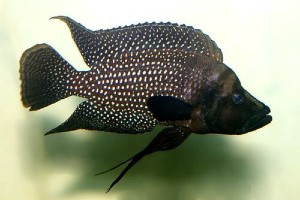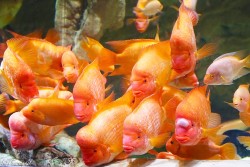Inkfin Calvus Cichlid (Altolamprologus calvus) CareSheet
 The Inkfin Calvus Cichlid (Altolamprologus calvus) is a large cichlid that may be found on the African coasts of Lake Tanganyika. This medium-sized species has a long lifespan and may be kept in a large tank with many other Tanganyikan cichlids. It has grown in popularity in the aquarium hobby over the last several years, but because to its sluggish growth rate, it demands patience to keep and reproduce. It's a substrate spawner that deposits her eggs in caves and shells. Compare with Altolamprologus compressiceps another impressive cichlid that is native to Lake Tanganyika.
The Inkfin Calvus Cichlid (Altolamprologus calvus) is a large cichlid that may be found on the African coasts of Lake Tanganyika. This medium-sized species has a long lifespan and may be kept in a large tank with many other Tanganyikan cichlids. It has grown in popularity in the aquarium hobby over the last several years, but because to its sluggish growth rate, it demands patience to keep and reproduce. It's a substrate spawner that deposits her eggs in caves and shells. Compare with Altolamprologus compressiceps another impressive cichlid that is native to Lake Tanganyika.The Inkfin Calvus Cichlid will flourish in an aquarium with lots of rocks, caves, and open swimming area. It should also be given a number of empty shells, which do not have to be of the Neothauma tanganyicense species. Because this cichlid does not dig much in the substrate, plants may be kept in the same tank with it. This species isn't very hostile in general, but it will protect its selected region. During spawning, territoriality is usually at its height. The Inkfin Calvus Cichlid should not be housed with dwarf shrimp or other tiny, sensitive invertebrates. If spawning is desired, other species should be kept to a minimum or avoided entirely unless the aquarium is large enough with enough of cover aquascaping. Because the male may sometimes consume the fry, spawning shells or caverns must be too tiny for him to enter.
The Inkfin Calvus Cichlid is a fuss-free feeder. High-quality frozen, freeze dried plankton and live meaty feeds, as well as dry foods, will be easily taken by tank-bred animals. This species should not be fed dry items entirely since quality and diversity are the keys to a diet that will guarantee that it maintains maximum health and color. It eats largely eggs, smaller fish, and fry in the wild. It will also benefit from a diet rich in vegetable matter.
Requirements for keeping Altolamprologus calvus
Temperature: 76° - 81° F
pH: 7.5 - 9.0
KH: 8 - 20 dKH
Minimum tank size: 15-20 gallons for a pair, 55+ gallons for a group
Origin: Indigenous to Lake Tanganyika, Africa
Average adult size: 5 inches for males. Females are much smaller


